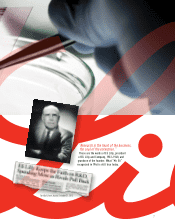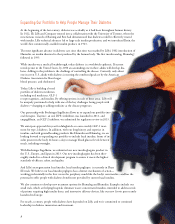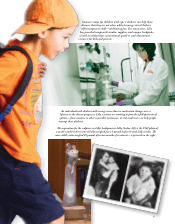Eli Lilly 2013 Annual Report Download - page 19
Download and view the complete annual report
Please find page 19 of the 2013 Eli Lilly annual report below. You can navigate through the pages in the report by either clicking on the pages listed below, or by using the keyword search tool below to find specific information within the annual report.
5
Important competitive factors for both human pharmaceutical and animal health products include
effectiveness, safety, and ease of use; price and demonstrated cost-effectiveness; marketing effectiveness;
and research and development of new products and processes. Most new products that we introduce must
compete with other branded or generic products already on the market or products that are later developed by
competitors. If competitors introduce new products or delivery systems with therapeutic or cost advantages,
our products can be subject to decreased sales, progressive price reductions, or both.
We believe our long-term competitive success depends upon discovering and developing (either alone or in
collaboration with others) or acquiring innovative, cost-effective human pharmaceutical and animal health
products that provide improved outcomes and deliver value to payers, together with our ability to continuously
improve the productivity of our operations in a highly competitive environment. There can be no assurance
that our research and development efforts will result in commercially successful products, and it is possible
that our products will become uncompetitive from time to time as a result of products developed by our
competitors.
Generic Pharmaceuticals
One of the biggest competitive challenges we face is from generic pharmaceuticals. In the U.S. and the EU,
the regulatory approval process for human pharmaceuticals (other than biological products (biologics))
exempts generics from costly and time-consuming clinical trials to demonstrate their safety and efficacy,
allowing generic manufacturers to rely on the safety and efficacy of the innovator product. Therefore, generic
manufacturers generally invest far less than we do in research and development and can price their products
much lower than our branded products. Accordingly, when a branded non-biologic human pharmaceutical
loses its market exclusivity, it normally faces intense price competition from generic forms of the product. In
many countries outside the U.S., intellectual property protection is weak and we must compete with generic or
counterfeit versions of our products. Many of our animal health products also compete with generics.
Biosimilars
Some of our current products, including Humalog, Humulin, Erbitux, and ReoPro, and many of the new
molecular entities in our research pipeline are biologics. Competition for Lilly’s biologics may be affected by
the approval of follow-on biologics, also known as biosimilars. A biosimilar is a biologic for which marketing
approval would be granted based on less than a full safety and efficacy package due to the physical/structural
similarity of the biosimilar to an already-approved biologic as well as reliance on the finding of safety and
efficacy of the already-approved product. Globally, governments have or are developing regulatory pathways
to approve biosimilars as alternatives to innovator-developed biologics, but the patent for the existing,
branded product must expire in a given market before biosimilars may enter that market. The extent to which
a biosimilar, once approved, will be substituted for the innovator biologic in a way that is similar to traditional
generic substitution for non-biologic products, is not yet entirely clear, and will depend on a number of
regulatory and marketplace factors that are still developing.
Managed Care Organizations
The growth of MCOs in the U.S. is also a major factor in the competitive marketplace for human
pharmaceuticals. It is estimated that approximately two-thirds of the U.S. population now participates in some
version of managed care. MCOs can include medical insurance companies, medical plan administrators,
health-maintenance organizations, Medicare Part D prescription drug plans, alliances of hospitals and
physicians and other physician organizations. MCOs have been consolidating into fewer, larger entities, thus
enhancing their purchasing strength and importance to us.
To successfully compete for business with MCOs, we must often demonstrate that our products offer not only
medical benefits but also cost advantages as compared with other medicines or other forms of care. As noted
above, generic drugs are exempt from costly and time-consuming clinical trials to demonstrate their safety
and efficacy and, as such, typically have lower costs than brand-name drugs. MCOs that focus primarily on
the immediate cost of drugs often favor generics for this reason. Many governments also encourage the use
of generics as alternatives to brand-name drugs in their healthcare programs. Laws in the U.S. generally
allow, and in many cases require, pharmacists to substitute generic drugs that have been rated under
government procedures to be essentially equivalent to a brand-name drug. The substitution must be made
unless the prescribing physician expressly forbids it.
























